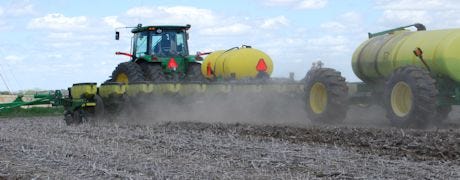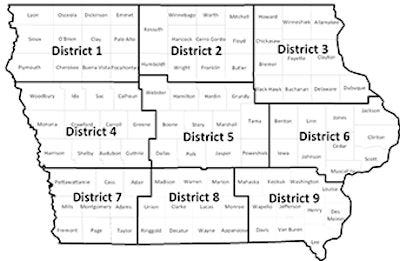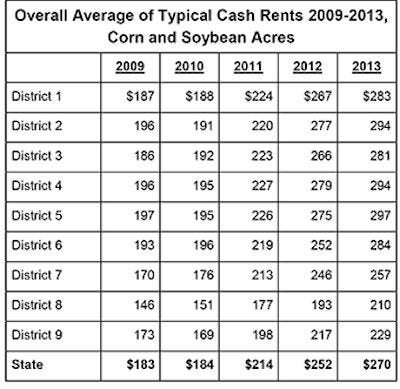May 15, 2013

Rental rates for Iowa farmland have been pushed significantly higher by the favorable corn and soybean prices farmers have enjoyed since 2010. This trend continued in 2013, but the rate of increase slowed considerably.

CASH RENT UP 7% IN 2013: Results from the recently released survey of farmland rental rates conducted by Iowa State University Extension show that the average estimated cash rent for corn and soybean land in the state for 2013 is $270 per acre, an increase of $18 per acre or 7% from last year. Thus, the uptrend continued in 2013 but the rate of increase has slowed considerably.
Results from the most recent survey of farmland rental rates conducted by Iowa State University Extension and Outreach showed that the average estimated cash rent for corn and soybean land in the state for 2013 was $270 per acre, an increase of $18 per acre or 7% from last year. This compares to increases of 16% in 2011 and 18% in 2012. Lower crop yields due to prolonged dry weather and lower price forecasts for the 2013 crop have tempered the optimism about prospective profits.
Average rents were moderately higher in all nine crop reporting districts, with increases ranging from 13% in east-central Iowa to 4% in southwest Iowa.
Typical rental rates per bushel of corn yield, soybean yield and CSR point were computed for each county and are available in the full report, "Cash Rental Rates for Iowa 2013 Survey". Typical charges for land growing oats and hay, for grazing pasture and cornstalks, and for renting hunting rights are also included in the report.
The intent of the ISU survey is to report typical rents being paid each year, not the highest nor the lowest values heard through informal sources, says ISU Extension economist William Edwards. He oversees the survey which is conducted each spring, with the help of ISU Extension program specialist Ann M. Johanns. The survey results are analyzed and released in early May.

Rental values were estimated by asking people familiar with land rental markets what they thought were typical rates in their county. The number of responses received this year was 1,703, a 20% increase from last year. Of the total responses, 50% came from farmers, 27% from landowners, 13% from professional farm managers, 8% from ag lenders and 2% from other professionals.~~~PAGE_BREAK_HERE~~~
The Cash Rental Rates for Iowa 2013 Survey is available online as a downloadable document from the ISU Ag Decision Maker website and the Extension Online Store.
Cash rental information presented in the survey is based on typical rates for high, medium and low-quality cropland

The people who were surveyed supplied information based on their best judgments about typical cash rental rates for high-, medium- and low-quality cropland in their counties, as well as for land devoted to production of hay, oats and pasture. Information about rents for individual farms was not collected. The rental rates summarized do not reflect the value of any buildings or storage structures, manure application contracts, or seed production contracts.
The cooperation and assistance of the landowners, farmers and agribusiness people who responded to this survey are greatly appreciated, says Edwards. He points out that circumstances such as the following may justify a higher or lower rent in speci?c cases:
• Small size or unusual shape of ?elds
• Presence of terraces or creeks that affect the time it takes to plant and harvest crops
• Dif?cult or restricted access to ?elds
• High or low fertility levels or pH index
• Existence of contracts for growing seed or specialty grains, or application of manure
• Above average local grain prices due to proximity to biofuel plants or feed mills
• USDA program variables, such as crop bases and assigned yields
• Longevity of the lease
• Other services performed by the tenant
More helpful information about setting cash rents is available
Additional information about cash rental rates by county is available from the National Agricultural Statistics Service (NASS) at the NASS website. Details about setting a fair cash rent can be found in the following Ag Decision Maker fact sheets, located under Whole Farm, Leasing, at this link.~~~PAGE_BREAK_HERE~~~
• Computing a Cropland Cash Rental Rate (File C2-20)
• Computing a Pasture Rental Rate (File C2-23)
• Flexible Farm Lease Agreements (File C2-21)
De?nitions used in the annual cash rent survey conducted by ISU Extension
Number of responses – number of individuals who reported typical rental rates for each county.
2008-2012 average yields – based on farm level data collected by National Agricultural Statistics Service (NASS) for each county. Average row crop CSR index – average traditional corn suitability rating (CSR) for the highest rated acres in each county, up to 110% of the number of acres planted to corn and soybeans in that county.
High, medium and low-quality third land – quality of land planted to corn and soybeans, using typical corn yields as a reference for land quality.
Typical corn yields – average yields for the high third, medium third, and low third productivity farms in each county as reported to NASS.
Average rents per unit – overall average rent for corn/soybean land in each county, divided by the ?ve-year average corn yield, the ?ve-year average soybean yield, and the average traditional CSR index value for each county.
Improved permanent pasture – pasture that contains both grasses and legumes and is regularly fertilized.
Unimproved pasture – pasture with mainly bluegrass that receives little fertilizer.
Pasture, $/AUM – rent charged per animal unit month. One AUM is equal to a beef cow and calf grazing for one month.
Cornstalk grazing – includes grazing of cornstalks but not mechanical harvesting.
Hunting rights – rent charged to allow hunting on land, per year.
For farm management information and analysis visit Ag Decision Maker; ISU farm management specialist Steve Johnson's site is available here.
You May Also Like




